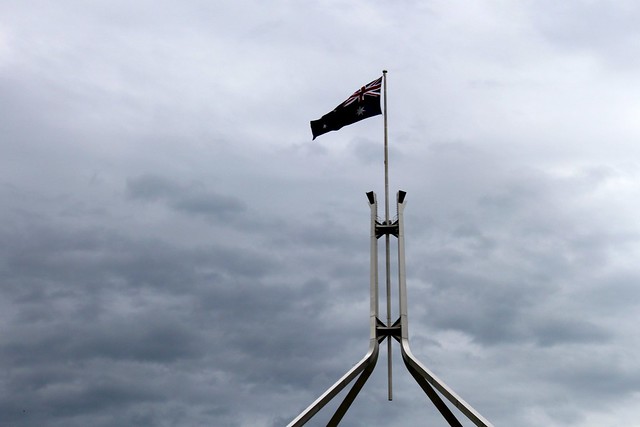
Most now agree that Russia interfered in the 2016 US presidential election, using social media manipulation to support its preferred candidate. In Australia, China has been engaging in old-fashioned influence operations.
To address concerns about interference, the Australian Electoral Commission is sharply upgrading its cybersecurity measures and installing new computer systems. Politicians are ramping up their monitoring and the parliament has passed new laws to deal with China’s activities. There remains, however, another less obvious threat to Australia’s foreign and defence policymaking.
Future governments are likely to face external online interference from state or non-state groups when trying to persuade Australians of the need to take military action overseas. This shift to a contested social environment reflects a revitalised appreciation of the importance of individual and collective views within society to the nation’s ability to defend itself. ‘The people’ are now being seen by some outside Australia as a centre of gravity that may be exploited to win future conflicts, potentially without any fighting at all.
Three broad strategies might be used by external entities to prevent Australian governments from mobilising the public to support national foreign and defence policies.
The simplest is to induce chaos. The Russian approach is to amplify divisive social issues by employing a wide-ranging disinformation attack across a nation’s political spectrum. Whether certain groups support the policies pushed by the Russians is immaterial. The aim is to drive a nation’s people to being more confrontational towards other.
The second strategy involves supporting ‘useful’ domestic groups. Terrorist groups like Islamic State have already targeted vulnerable individuals on a small scale using human-intensive techniques. Now, though, big data, artificial intelligence and social media are making large-scale manipulation of groups of people feasible.
The third and hardest strategy aims at changing people’s minds. This includes acting top-down through ‘thought leaders’. Here, big data, data mining, micro-targeting and deep fakes offer new technological solutions.
The three strategies all need to leverage off the target society and require an accessible and malleable audience to be successful.
Technical measures alone are unlikely to be enough of a defence given the extent of social media take-up across Australian society. Indeed, a lot of the technical measures that are being taken are meant to protect not the public but rather the computer systems of government agencies and the parliament. In practise, technical measures need to be complemented with non-technical ‘foreground’ and ‘background’ approaches to thwart an adversary’s counter-mobilisation strategies.
Non-technical foreground approaches involve building legitimacy and crafting a strategic narrative.
In this context, legitimacy mainly involves the assessments individuals make of specific actions their government is undertaking. If the actions are deemed legitimate, people will end to support the government and accept the demands made of them. Importantly, they will not actively try to subvert the government and will generally self-police to ensure others don’t either. Building legitimacy involves assuring the public that the proposed action accords with societal norms, stressing that the government has appropriate expertise to deal with a situation, asserting that the actions being taken will work and, most importantly, having a compelling rationale.
The second, concurrent, foreground measure involves crafting a narrative to tell a story about the strategy being implemented in a way that frames issues and policies within a consistent and coherent conceptual framework. The narrative provides an interpretive structure that people can use to make sense of historical facts, current problems and emerging issues.
Non-technical background measures work differently. They aim to favourably shape the terrain on which the online battle of ideas is being waged. Australia’s home front experience during World War II offers two useful insights, both of which were eloquently explained by official historian Paul Hasluck 25 years ago.
The first is that commercial imperatives drove the non-government media to focus on bad news, while the government media, in a quandary about how to remain party-neutral, decided that the best approach was to simply censor almost all news (see Hasluck, pages 402–407). The Department of Information became the ‘department of suppression’.
The result was that people didn’t have access to an information source that gave a balanced perspective. Citizens of a democracy need to have high-quality information to make reasoned judgements about a government’s actions. This remains a difficult issue, but there is time now to develop solutions. The alternative is to leave a void that adversaries intent on social disruption can exploit.
Second, Australia’s leadership didn’t appear to fully trust the people. Hasluck observed (page 628) that a prominent feature of the Australian wartime home front was:
the lack of confidence that wartime leaders had in their people. They often complained, cajoled and even threatened, and they constantly exhorted the people to do more, but seldom did they appear to trust them. Seldom did they make the confident demand of leaders who are sure that their people are good, sound at heart and resolute.
If future Australian governments seek the people’s support, they might usefully base their rhetoric on the assumption that they ‘are good, sound at heart and resolute’. This may be especially necessary if a balanced source of information isn’t available to the public. A leader’s statements will then form the principal counterweight to more troubling opinions elsewhere and help shape a future online battle of ideas.
Social mobilisation may seem arcane. But adversaries that seek to manipulate Australians’ views to alter the government’s foreign and defence policies already have the online mechanisms available to try to do that. With such external social disruption operations possible for the foreseeable future, thought needs to be given to responses.

